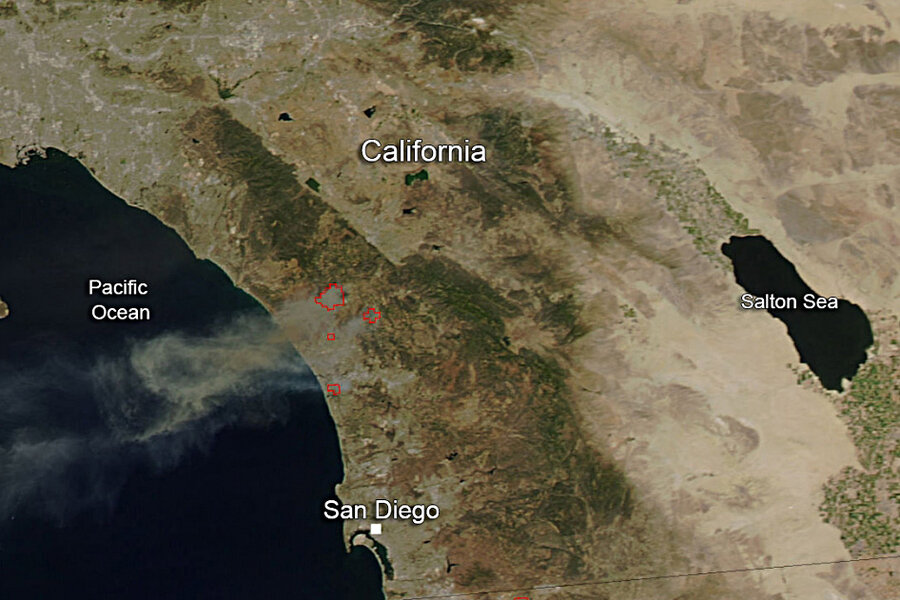California wildfires can be seen from space. Is that actually impressive?
Loading...
NASA's Aqua satellite has beamed home an image of the sand-colored smoke that was fanning out over the Pacific Ocean on Thursday, from 11 separate fires that continue to rage near San Diego, California. With the first of those fires now traced to a backhoe used during an excavation project, according to the LA Times, and three arson arrests made, this large constellation of blazes may be the latest man-made feature visible from outer space.
Run jointly by the US, Japan, and Brazil, Aqua circles the Earth from pole to pole once per day. It gathers information on Earth systems like fluxes in radiation, atmospheric gases, vegetation cover, and ocean particles. Photography is just one of the satellite's many tools; its temperature-based images are used around the world by natural resource agencies looking to locate and manage fires.
"Almost all the forest departments are using this product in different parts of the world," says Krishna Vadrevu, a researcher at University of Maryland, College Park, who studies how governments make use of Aqua's heat maps. The Indian state of Madhya Pradesh, he says, recently found that 85 percent of Aqua's fire detections turned out to be correct.
Aqua orbits at an average altitude of 438 miles – which would almost certainly not allow human eyes to see this particular patch of smoke, if they were to board the orbiter (they don't). In the satellite's fire-related photographs, says Dr. Vadrevu, each pixel represents about one square kilometer. At that resolution, he says, the photographs can distinguish different landscape features like agricultural areas, forest cover, bodies of water, and cities.
But the International Space Station (ISS) and the three astronauts currently aboard it, hurtle around us at half that distance – 220 miles – and a sixteen times faster rate of orbit, circling the Earth every 90 minutes. And those astronauts can see all kinds of Earthly activities.
NASA spokesman Kelly Humphries says the ISS barreled over California early Friday morning, and its occupants probably saw the San Diego fires with their naked eyes, if their research schedule permitted.
"They can see the smoke from fires like this," he says. "All those myths about only being able to see the Great Wall of China are hogwash. They can see lots of things on the ground, like roads, crop circles, and city lights at night." They can even make out the white-capped wakes made by large ships, he adds. What helps most is the presence of a strong color contrast.
"A farmer from Louisiana could be burning trash in his back yard, and it would make a big enough smoke trail that they could see it from space," says Mike Gentry, a photo researcher for NASA's human-tended vehicles. "And it's quite a priority to the astronauts and cosmonauts, it anything like that's going on. Be it a typhoon, or a big wildfire."
And with their camera's zoom lenses, space station astronauts can even keep tabs on their home teams. "It can safely be said, a lens on a camera can almost pick up home plate on Minute Maid stadium in Houston," says Mr. Gentry. "The naked eye can see patterns of streets and rivers. You'd be surprised sometimes at the smallness of things."








